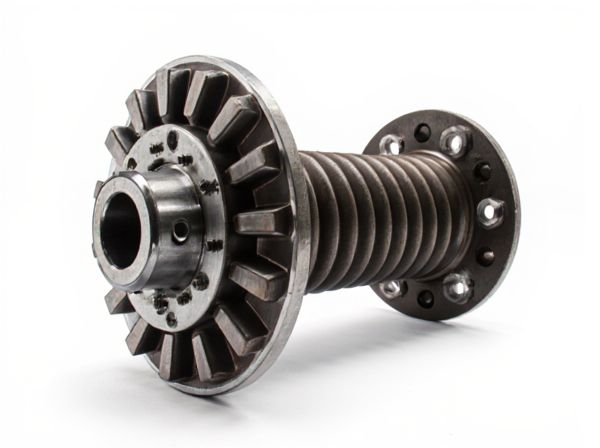
Photo illustration: Helical Differential vs Plate Differential
Helical differentials use angled gears to provide smooth torque distribution and enhanced traction, especially on uneven surfaces, making them ideal for off-road and high-performance applications. Plate differentials, often referred to as clutch or limited-slip differentials, rely on friction plates to control wheel slip, offering precise control in cornering and improved handling. Understanding the key differences helps you select the best differential type for your vehicle's driving conditions and performance needs.
Table of Comparison
| Feature | Helical Differential | Plate Differential |
|---|---|---|
| Design | Uses helical gears for smooth torque distribution | Utilizes clutch plates to control wheel slip |
| Torque Distribution | Automatic and continuous torque adjustment | Torque limited by friction on clutch plates |
| Durability | High durability with minimal wear | Moderate durability; plates can wear out |
| Maintenance | Low maintenance due to gear-based design | Requires periodic plate replacement or adjustment |
| Performance | Improved traction on slippery surfaces | Effective in high-performance and off-road conditions |
| Cost | Generally higher initial cost | Typically lower initial cost but higher upkeep |
Introduction to Vehicle Differentials
Helical differentials use spiral bevel gears that provide smooth torque distribution and enhanced traction control, making them ideal for performance and off-road vehicles. Plate differentials, commonly known as clutch or limited-slip differentials, employ friction plates to modulate power transfer between wheels, improving grip on slippery surfaces. Both types play critical roles in managing wheel speed variations and maintaining vehicle stability during turns.
What is a Helical Differential?
A helical differential uses angled helical gears to distribute torque smoothly between wheels, providing better traction and reducing drivetrain noise compared to traditional plate differentials that rely on clutch plates. This design allows for continuous power transmission even during wheel slip, enhancing vehicle stability and cornering performance. Helical differentials are commonly found in performance and all-wheel-drive vehicles due to their durability and efficient torque vectoring capabilities.
How a Helical Differential Works
A helical differential uses spiral-shaped gears to transmit torque between wheels, allowing for smooth power distribution while enabling wheel speed differentiation during turns. Its design reduces noise and wear compared to traditional plate differentials by relying on constant-mesh gearsets rather than friction plates. This mechanism improves traction and handling performance in various driving conditions, making it popular in advanced all-wheel-drive systems.
Plate Differential: Design and Function
Plate differentials utilize a stack of friction plates and steel plates to distribute torque between wheels, offering superior traction control compared to helical differentials. The design includes alternating friction and drive plates housed in a compact casing, enabling progressive lock-up under load and enhanced performance on uneven terrain. This clutched mechanism provides reliable torque biasing, making plate differentials ideal for high-performance and off-road vehicles.
Comparing Helical and Plate Differentials
Helical differentials utilize spiral gears to distribute torque smoothly and quietly, providing enhanced traction on slippery surfaces compared to plate differentials, which rely on friction plates and springs to manage power transfer. Helical differentials offer continuous, automatic torque vectoring without the need for electronic controls, making them more reliable under variable driving conditions, while plate differentials can suffer from wear and require precise maintenance due to their mechanical complexity. The choice between helical and plate differentials depends on factors like desired durability, noise levels, and driving environment, with helical designs favored for all-wheel-drive systems requiring consistent torque distribution.
Performance Benefits of Helical Differentials
Helical differentials offer superior traction and smoother torque distribution compared to plate differentials due to their spiral gear design, which enhances power transfer efficiency. The continuous mesh of helical gears reduces noise and wear, resulting in increased durability and lower maintenance requirements. Their ability to maintain better grip under varying load conditions improves overall vehicle handling and stability, particularly in off-road or high-performance applications.
Plate Differential Advantages and Limitations
Plate differentials offer superior torque vectoring capabilities, allowing for better traction and handling compared to helical differentials. They are typically lighter and more compact, making them ideal for performance vehicles where weight reduction is crucial. However, plate differentials may require more frequent maintenance due to increased wear and can be more expensive to manufacture and repair than helical differentials.
Applications: Helical vs Plate Differentials
Helical differentials are widely used in high-performance and off-road vehicles due to their smooth power distribution and superior traction on slippery surfaces. Plate differentials, commonly found in racing and drift applications, offer precise torque control and quick response but may require more frequent maintenance. The choice between helical and plate differentials depends on the specific vehicle application, with helical types favored for durability and all-terrain capability, while plate differentials excel in aggressive driving and motorsport environments.
Maintenance and Longevity Considerations
Helical differentials generally require less frequent maintenance due to their enclosed design and smoother gear meshing, which reduces wear and extends component life. Plate differentials, while offering robust performance, often need more regular inspection and lubrication to prevent plate wear and maintain optimal functionality. Proper maintenance intervals and quality lubrication critically influence the longevity of both differential types, with helical systems tending to offer longer service intervals under comparable operating conditions.
Choosing the Right Differential for Your Vehicle
Choosing the right differential for your vehicle depends on your driving needs and terrain. Helical differentials provide smooth power distribution and improved traction on slippery surfaces, making them ideal for off-road and all-wheel-drive applications. Plate differentials, often found in limited-slip setups, enhance cornering stability and performance in high-torque situations, preferred for racing or sports cars.
 caratoz.com
caratoz.com